Thanks, but my idea is much more primitive. I don’t have a voice coil, but a solenoid. I don’t have delicate suspension, I have a couple of magnets repelling.Joppe is experimenting with 4 neodymium magnets 5 years ago.
At 51 seconds, you'd see how the sound was transferred to the DML. They look like two panels held together and the sound is transferred through the a little area of the edge in the middle to both panels.
View attachment 1121644
The flat (printed) voice coil is pasted between the two pieces of paper, which are also pasted to each other. The elastic string is to bring back the voice coil from jumping off and keeping it centred between the magnets.
Burntcoil.
Joppe is very open about what he does, and demonstrates how to do things, unlike some.
I intend to improve the ply and others stiff panels(I hope, if it works?) Next, year when I get time.
Or maybe panels in general, I will have to wait and see how it goes.
I have a few projects to test out and build a panel for a friend.
Hopefully it should be interesting.
Building a simple new type of exciter sounds fun, but how practical it will be , I'm not sure.
But it is worth a try.
Steve.
Joppe is very open about what he does, and demonstrates how to do things, unlike some.
I intend to improve the ply and others stiff panels(I hope, if it works?) Next, year when I get time.
Or maybe panels in general, I will have to wait and see how it goes.
I have a few projects to test out and build a panel for a friend.
Hopefully it should be interesting.
Building a simple new type of exciter sounds fun, but how practical it will be , I'm not sure.
But it is worth a try.
Steve.
The voice coil must've been printed from an alu foil. He'd been using an ink printer those days. Before this, he had been experimenting with Haddock's ideas, the rubanoide etc.Thanks, but my idea is much more primitive. I don’t have a voice coil, but a solenoid. I don’t have delicate suspension, I have a couple of magnets repelling.
I am exploring three possible directions at the moment. A preview below.Burntcoil.
Joppe is very open about what he does, and demonstrates how to do things, unlike some.
I intend to improve the ply and others stiff panels(I hope, if it works?) Next, year when I get time.
Or maybe panels in general, I will have to wait and see how it goes.
I have a few projects to test out and build a panel for a friend.
Hopefully it should be interesting.
Building a simple new type of exciter sounds fun, but how practical it will be , I'm not sure.
But it is worth a try.
Steve.
Burnt
Attachments
-
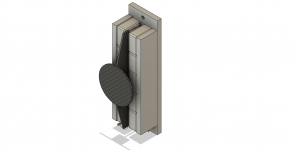 Linear Exciter v18.png60.5 KB · Views: 96
Linear Exciter v18.png60.5 KB · Views: 96 -
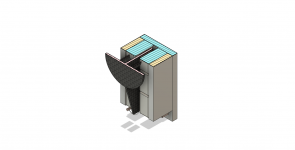 Linear Exciter v18 SECTION.png40.3 KB · Views: 114
Linear Exciter v18 SECTION.png40.3 KB · Views: 114 -
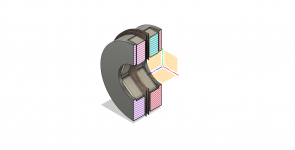 Flat Motor 2 SML v10 SECTION.png35.9 KB · Views: 91
Flat Motor 2 SML v10 SECTION.png35.9 KB · Views: 91 -
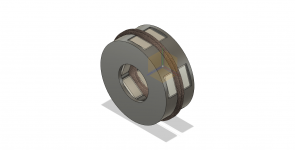 Flat Motor 2 SML v10.png58.3 KB · Views: 99
Flat Motor 2 SML v10.png58.3 KB · Views: 99 -
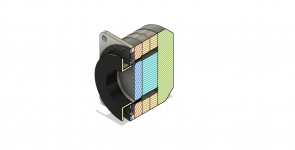 Exciter 40mm OD 26mm VC v32 SECTION.png37.2 KB · Views: 91
Exciter 40mm OD 26mm VC v32 SECTION.png37.2 KB · Views: 91 -
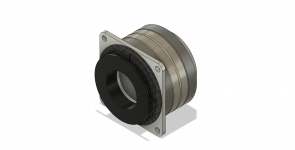 Exciter 40mm OD 26mm VC v32.png77.8 KB · Views: 96
Exciter 40mm OD 26mm VC v32.png77.8 KB · Views: 96
• XPS is manufactured in a continuous extrusion process that produces a homogeneous closed cell cross section.
• EPS is manufactured by expanding spherical beads in a mould, using heat and pressure to fuse the beads together where they touch, leaving open spaces between the beads where they don’t touch.
Although both types are comprised of polystyrene, the two types of manufacturing processes produce finished products with very different performance properties. Of the two types, EPS absorbs more water in laboratory tests and in application resulting in reduced performance (as an insulating material in construction).
Using EPS for the purpose of a DML panel, adding diluted PVA to its surface would only block the nearest empty spaces of the surface. Even, if you paint all the 6 surfaces (2 flat and 4 edges) you'd still have empty spaces within the EPS sheet. Inside the EPS sheet, the spherical polystyrene beads are suspended in air, holding each other by surface tension.
XPS also absorbs water in time, even though its surface looks monolithic, that is, there is air within the XPS sheet. There's a never-ending fight between the EPS and XPS manufacturers in this area. In colder countries, the water consumption by any insulating material is a problem due frost and thaw.
Both EPS and XPS are also very good heat and sound insulators, but EPS is better at it than XPS, especially because of the amount of air trapped in it, that is amount of so-called empty spaces. All foam material (polystyrene, PIR, phenolic, etc) has air trapped in them, some of them has all 6 surfaces blocked as they are extruded.
--------------------------
1) Why there is a tunnel effect in EPS, depending on the thickness of the sheet?
Sound goes everywhere from the exciter. It may travel along the surface, bumping from one polystyrene bead, or going through it, to another. It may go across the EPS sheet in all directions, going through the beads, and then through the 'empty' space into the next bead, and/or bumping of the surface of the bead. Sound (waves) can come out of any place from the other side of the panel, or even from the edges. So, we can assume that thinner the EPS sheet, better the sound. But, very thin (1mm or even less) would simply crack. (I've seen very thin EPS sheets at the factory.)
2) The pebble in pond effect, do the waves really return?
Why should they? EPS (or XPS) is not a liquid. The liquids need a container. Waves hit the bank and return in a pond. The EPS (or XPS) sheet edge is not a barrier. It is open to the air. The sound waves would simply move out from the higher density material (EPS, XPS) to air (low density). They'd go out from the shortest edge quicker than from the longest edge. (The few commercial producers of flat panel speaker available atm in the world, such as Amina Sound, Tectonic etc block the edges with damping material. Amina Sound actually plaster their flat speakers in walls, not very worried about plaster cracking.)
3) Why the edge fixed exciter at the centre gives much clearer and fuller sound from a flat panel? Why glass gives a better sound than EPS or XPS this way?
My piano tuner friend says that the sound moves out like a balloon, mostly forward, depending how the source of the sound is directed. (He is a piano player and a music teacher.) So, the sound balloons off much faster in the high-density glass, and then passes out to the low-density air. Only, it happens so fast for our ears to catch the difference. Glass is much more homogeneous than EPS.
4) Why the curved flat surface, paper in this case, gives out even more clear and full sound than the same paper kept straight with edge transfer of sound? Telefunken Arcophon from 1926 and Paul Haddock's patents from 1990 to 1998.
View attachment 1121636
A piezoelectric driver (20) is the sound source. Flat upturned triangle (18) is the bridge. The curved paper membranes (26) are the DML panels. The membranes are fixed and damped along the perimeter, half of which is practically flat. Of course, this is just a patent, probably the speaker had not been made after the patent was issued, but Telefunken had sold Arcophon speakers with the same idea from 1926-1932. The point transfer of the sound vibrations/waves to an edge of two curved flat panels, in this case paper. In this patent, the perforated edge of the bridge transfers the energy/waves/vibrations to a thin strip at the edge of the two DML panels. Why it gives clearer, fuller sound is not yet answered.
Its not only the thickness of the EPS that determines the so called tunnel (hollow/echo) effect but also the density of the EPS panel as there are various densities ranging from under 1lbs to 5lbs. Its the combination of thickness and density in the right ratio.
Pebble in the pond is just an analogy its not a liquid I agree. Speed of ripples in a pond moves way slower then the speed of sound vibrating through the panel. In fact the vibrations move so fast that most of the sound travels to the edges of the panel where its released at the edges. Damping of the edges using foam, rubber, cloth etc. will reduce it. Its the same with conventional cone drivers using some type of surround material at the edge of the cone diaphragm.
The rest I dont agree with it being better so I wont comment. lol
Last edited:
I am exploring three possible directions at the moment. A preview below.
Burnt
For those interested
https://www.diyaudio.com/community/threads/dml-exciter-design.393544/#post-7209266
Burnt
It is the matter of how much air trapped in the EPS sheet. Density means how much pressure applied while producing the EPS block.Its not only the thickness of the EPS that determines the so called tunnel (hollow/echo) effect but also the density of the EPS panel as there are various densities ranging from under 1lbs to 5lbs. Its the combination of thickness and density in the right ratio.
And, they don't return as in a liquid.Pebble in the pond is just an analogy its not a liquid I agree. Speed of ripples in a pond moves way slower then the speed of sound vibrating through the panel. In fact the vibrations move so fast that most of the sound travels to the edges of the panel where its released at the edges.
That pressure applied makes the panel dense and a denser material reduces the tunnel effect. Higher density less air trapped. Thats why a 5lbs density EPS has way less tunnel effect then a 1lbs density EPS.It is the matter of how much air trapped in the EPS sheet. Density means how much pressure applied while producing the EPS block.
And, they don't return as in a liquid.
Yes I agree they dont return as a liquid. What the foam, rubber, cloth etc does is reduce the vibrations from the edges just like a conventional cone drivers surround material.
Last edited:
Sure they do. Waves are reflected from edges and form modal patterns. See Chladni plates demos on youtube. This knowledge, and the math that goes with it are the reason why we can predict the resonance frequencies of rectangular plates accurately, either with a direct formula for simple cases or with FEM for cases for which there is no closed-form solution.And, they don't return as in a liquid.
But I think you've been advised of this before, no?
I was talking about the pressure applied to polystyrene beads when the EPS block was made. The panels are made by cutting the block with heated wire. EPS (and XPS) sheets are made primarily for construction purposes, usually used for thermal and sound insulation. EPS decays after a while.That pressure applied makes the panel dense and a denser material reduces the tunnel effect. Higher density less air trapped. Thats why a 5lbs density EPS has way less tunnel effect then a 1lbs density EPS.
That is the air dancing just above the plate, getting different frequencies. Ripples don't happen on solid surfaces, and if they happen they stay, deforming the surface. Ripples happen and die only on liquid surfaces.Sure they do. Waves are reflected from edges and form modal patterns. See Chladni plates demos on youtube. This knowledge, and the math that goes with it are the reason why we can predict the resonance frequencies of rectangular plates accurately, either with a direct formula for simple cases or with FEM for cases for which there is no closed-form solution.
The air dances because the plate dances. With enough force, even rock dances (ever heard of earthquake waves?). Solids absolutely do support waves - compression waves, bending waves, lamb waves, SAW waves. They deform and do not crease or permanently deform, unless the forces at play are beyond the elastic limit. It is very well established science, since hundreds of years it's been understood. Yet you keep repeating this. Read a book if you don't believe anyone here. Any good book on acoustics will cover this.
I thought we were talking about the tunnel effect? Yes I have a hot wire cutter it works great for cutting EPS......As long as EPS is not exposed to harsh elements it can last a very long time. My Bertagni speakers is around 40 something years old and the EPS diaphragm is still in good condition.I was talking about the pressure applied to polystyrene beads when the EPS block was made. The panels are made by cutting the block with heated wire. EPS (and XPS) sheets are made primarily for construction purposes, usually used for thermal and sound insulation. EPS decays after a while.
It only works if they start full. 😀I tried this with 2 different bottles - one very heavy single malt bottle and one Jim Beam Black. I just held it to the neck ring. Failed to get excited about it and ditched the bottles (they were already empty) 😊
Probably needed more patience..😒
Eucy
Ripples can happen on solid surface. There is water ripple and sound ripple. Water ripple is visible sound ripple is not. When I use 2 DAEX30HESF-4 exciters on a single panel with a sub amp you will literally see the panel bend starting from the middle and flapping wildly at the four corners.That is the air dancing just above the plate, getting different frequencies. Ripples don't happen on solid surfaces, and if they happen they stay, deforming the surface. Ripples happen and die only on liquid surfaces.
Last edited:
Tunnel effect happens because of the trapped air in the EPS sheet, and its thickness. The density of the EPS sheet depends on the pressure applied at the manufacturing state. EPS is manufactured primarily for construction matters. The same thickness of EPS75 sheet would give more tunnel effect than EPS300, which is more compact, that is, less trapped air.I thought we were talking about the tunnel effect? Yes I have a hot wire cutter it works great for cutting EPS......As long as EPS is not exposed to harsh elements it can last a very long time. My Bertagni speakers is around 40 something years old and the EPS diaphragm is still in good condition.
Audiofrenzy,My newest DML panel that I built yesterday. Not completely done but they sound really good IMO.
Planning to share your designs? Sorry if you have and I missed the post. There are so many lately.
Eric
No way , I am embarrassed as my designs are inferior to yawls. Also I only have around 8 years experience so I dont know what I am talking about so take all my advice like a grain of salt. LOL
Just for fun I asked the GPTChat AI https://chat.openai.com/chat about holes and wavelength and got this answer.
"
... an array of small holes in a panel can potentially absorb sound waves that are propagating through the panel, even if the wavelength of the sound waves is greater than the small hole diameter.
One way that small holes in a panel can absorb sound waves propagating through the panel is by creating a scattering effect. When sound waves encounter the holes, they can be scattered in different directions, resulting in energy being dissipated and absorbed by the panel. This can be effective at absorbing low-frequency sound waves, as the scattering effect becomes more pronounced at lower frequencies.
Another way that small holes in a panel can absorb sound waves propagating through the panel is by creating a resonant effect. When sound waves encounter the holes, they can excite resonances within the panel, resulting in energy being dissipated and absorbed by the panel. This can be effective at absorbing higher-frequency sound waves, as the resonant effect becomes more pronounced at higher frequencies.
It's important to note that the effectiveness of small holes in a panel at absorbing sound waves will depend on a variety of factors, including the size, shape, and spacing of the holes, as well as the material of the panel and the characteristics of the incident sound waves."
Which I was amazed by. It quite a cool tool and free to use.
Burnt
"
... an array of small holes in a panel can potentially absorb sound waves that are propagating through the panel, even if the wavelength of the sound waves is greater than the small hole diameter.
One way that small holes in a panel can absorb sound waves propagating through the panel is by creating a scattering effect. When sound waves encounter the holes, they can be scattered in different directions, resulting in energy being dissipated and absorbed by the panel. This can be effective at absorbing low-frequency sound waves, as the scattering effect becomes more pronounced at lower frequencies.
Another way that small holes in a panel can absorb sound waves propagating through the panel is by creating a resonant effect. When sound waves encounter the holes, they can excite resonances within the panel, resulting in energy being dissipated and absorbed by the panel. This can be effective at absorbing higher-frequency sound waves, as the resonant effect becomes more pronounced at higher frequencies.
It's important to note that the effectiveness of small holes in a panel at absorbing sound waves will depend on a variety of factors, including the size, shape, and spacing of the holes, as well as the material of the panel and the characteristics of the incident sound waves."
Which I was amazed by. It quite a cool tool and free to use.
Burnt
Hi DMLBES.No way , I am embarrassed as my designs are inferior to yawls. Also I only have around 8 years experience so I dont know what I am talking about so take all my advice like a grain of salt. LOL
I noticed it was you some time ago ,but you were being so nice I did not say anything.
But I can tell you are going to kick off again.
Should I not share my new ideas ?
Or shall I keep them to myself to the grave ?
Have you applied for patents yet so we can read all about them ?
Steve.
- Home
- Loudspeakers
- Full Range
- A Study of DMLs as a Full Range Speaker